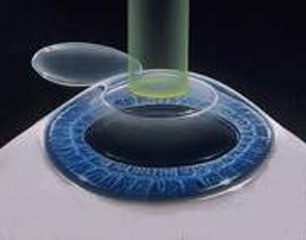Refractive Surgery Options
LASIK is the most advanced refractive surgical procedure available today and can correct low to severe degrees of myopia and astigmatism and moderate degrees of hyperopia (farsightedness). It also requires a higher degree of skill and experience on behalf of the surgeon.
The eye is anesthetized with eye drops. Rather than removing the corneal surface layers as described for PRK, a precision instrument called a “microkeratome” is used to create a thin flap of corneal tissue that remains attached to the eye in a hinge-like fashion. After the Excimer laser sculpts the deeper corneal layers, the flap is replaced to its original position. In this way, the healing time needed for the surface cells to regenerate is eliminated and post-operative comfort is maximized.
Wavefront – Guided LASIK
Wavefront-guided LASIK is a variation of LASIK surgery where, rather than applying a simple correction of focusing power to the cornea (as in traditional LASIK), our surgeon applies a spatially varying correction, guiding the computer controlled excimer laser with measurements from the wavefront sensor. The goal is to achieve a more optically perfect eye, however, the final outcome of this technology depends on the success of the surgeon in predicting changes which will occur during healing. Our surgeon, Dr. Hiss, has successfully calculated thousands of LASIK outcomes using the Wavefront-guided technology with lowered incidence of “halos” and higher patient satisfaction.
PRK (Photorefractive Keratectomy)
Photorefractive Keratectomy is performed to correct mild to moderate degrees of myopia and astigmatism, and requires no incisions. With PRK, the surgeon uses the computer-assisted Excimer Laser to flatten the cornea by removing a layer approximately the thickness of a human hair. There is no pain during the procedure, as anesthetic eye drops insure maximum comfort.
The laser is a cool, non-thermal form of light energy that does not burn or damage the delicate tissue surrounding the treated area. The surface of the eye heals within three days, during which time a protective contact lens is worn.
Clear Lens Extraction
Clear Lens Extraction involves removing the internal lens of the eye, just like in a cataract operation. This is done with a special ultrasound instrument and may be done with eye-drop anesthesia (similar to LASIK). The procedure can be performed without the need for stitches. A flexible synthetic lens implant of the proper power is then placed inside the eye through an extremely small incision to correct the refractive error.
This Procedure is more commonly performed for treating higher levels of farsightedness in patients over age forty. The optical results are excellent and the visual recovery period is brief. Clear Lens Extraction may also be used to correct higher levels of nearsightedness and may be fine tuned with LASIK if a small refractive error remains. Our doctor may discuss this procedure with you if you are not a candidate for PRK or LASIK.
Phakic Intraocular Lenses
Phakic intraocular lenses, or phakic lenses, are lenses made of plastic or silicone that are implanted into the eye permanently to reduce a person’s need for glasses or contact lenses. Phakic refers to the fact that the lens is implanted into the eye without removing the eye’s natural lens. During Phakic lens implantation surgery, a small incision is made in the front of the eye. The Phakic lens is inserted through the incision and placed just in front of or just behind the iris.
Phakic lenses are used to correct refractive errors, errors in the eye’s focusing power. Currently all Phakic lenses are approved by the FDA are for the correction of nearsightedness (myopia).
Phakic intraocular lenses are implanted in the eye without removing the natural lens. This is in contrast to intraocular lenses that are implanted into eyes after the eye’s cloudy natural lens (cataract) has been removed during cataract surgery.
Phakic lenses are intended to be permanent. While the lenses can be surgically removed, it cannot be guaranteed your eye will return to your previous level of vision or condition.




